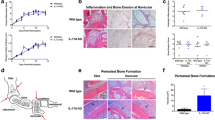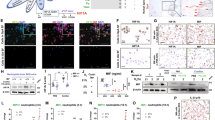Abstract
Aberrant endochondral bone formation in the physis is a unique bone lesion in neonatal-onset multisystem inflammatory disease (NOMID), also called chronic infantile neurologic cutaneous articular (CINCA), the most severe of the cryopyrin-associated periodic syndrome (CAPS) diseases, which are interleukin-1β (IL-1β)-related monogenic autoinflammatory diseases. The wingless (Wnt) pathway plays an important role in osteoblast differentiation. In this study, we explored the potential role of IL-1β on the expression of WNT genes and the Wnt antagonist Dickkopf-1 (DKK1). The expression of WNT and DKK1 in fibroblast-like synoviocytes (FLS), which are articular resident cells, was quantified by quantitative PCR and enzyme-linked immunosorbent assay. Additionally, we used T cell factor (TCF) reporter assays to evaluate the activity of the canonical Wnt signal pathway in the presence or absence of the supernatant of cultured FLS treated with or without IL-1β and IL-6. Anti-DKK1 antibodies were used to neutralize DKK1. The expression of both canonical and non-canonical WNT genes as well as DKK1 was observed in FLS. The supernatant of cultured FLS suppressed the luciferase activity of the TCF reporter, and this effect was reduced by its pre-treatment with an anti-DKK1 antibody. Both IL-1β and IL-6 significantly reduced DKK1 production. Furthermore, the supernatant of FLS cultured with IL-1β or IL-6 showed a reduced inhibitory effect on Wnt signaling, compared with the supernatant of untreated FLS. These data suggest that IL-1β, like IL-6, dampens DKK1 production, and thereby promotes Wnt signal activation. Therefore, increased levels of IL-1β may contribute to the dysregulation of endochondral ossification in NOMID/CINCA.




Similar content being viewed by others
References
Kuemmerle-Deschner, Jasmin B. 2015. CAPS—pathogenesis, presentation and treatment of an autoinflammatory disease. Seminars in Immunopathology 37: 377–385. https://doi.org/10.1007/s00281-015-0491-7.
Manthiram, Kalpana, Qing Zhou, Ivona Aksentijevich, and Daniel L. Kastner. 2017. The monogenic autoinflammatory diseases define new pathways in human innate immunity and inflammation. Nature Immunology 18: 832–842. https://doi.org/10.1038/ni.3777.
So, Alexander, Annette Ives, Leo A.B. Joosten, and Nathalie Busso. 2013. Targeting inflammasomes in rheumatic diseases. Nature reviews. Rheumatology. 9: 391–399. https://doi.org/10.1038/nrrheum.2013.61.
Jesus, Adriana A., and Raphaela Goldbach-Mansky. 2014. IL-1 blockade in autoinflammatory syndromes. Annual Review of Medicine.65: 223–244.https://doi.org/10.1146/annurev-med-061512-150641.
Goldbach-Mansky, Raphaela. 2011. Immunology in clinic review series; focus on autoinflammatory diseases: update on monogenic autoinflammatory diseases: the role of interleukin (IL)-1 and an emerging role for cytokines beyond IL-1. Clinical and Experimental Immunology 167: 391–404.
Caorsi, Roberta, Silvia Federici, and Marco Gattorno. 2012. Biologic drugs in autoinflammatory syndromes. Autoimmunity Reviews. 12: 81–86. https://doi.org/10.1016/j.autrev.2012.07.027.
Fenini, Gabriele, Emmanuel Contassot, and Lars E. French. 2017. Potential of IL-1, IL-18 and inflammasome inhibition for the treatment of inflammatory skin diseases. Frontiers in Pharmacology 8. https://doi.org/10.3389/fphar.2017.00278.
Kuemmerle-Deschner, Jasmin B., Seza Ozen, Pascal N. Tyrrell, Isabelle Kone-Paut, Raphaela Goldbach-Mansky, Helen Lachmann, Norbert Blank, Hal M. Hoffman, Elisabeth Weissbarth-Riedel, Boris Hugle, Tilmann Kallinich, Marco Gattorno, Ahmet Gul, Nienke Ter Haar, Marlen Oswald, Fatma Dedeoglu, Luca Cantarini, and Susanne M. Benseler. 2017. Diagnostic criteria for cryopyrin-associated periodic syndrome (CAPS). Annals of the Rheumatic Diseases. 76: 942–947. https://doi.org/10.1136/annrheumdis-2016-209686.
Goldbach-Mansky, Raphaela. 2011. Current status of understanding the pathogenesis and management of patients with NOMID/CINCA. Current Rheumatology Reports. 13: 123–131. https://doi.org/10.1007/s11926-011-0165-y.
Chirathivat, Suvimol H., Madjimbaye Namde, Andrew Dwyer, Andrew Poznanski, Scott Canna, and Raphaela Goldbach-Mansky. 2007. Arthropathy of neonatal onset multisystem inflammatory disease (NOMID/CINCA). Pediatric Radiology. 37: 145–152. https://doi.org/10.1007/s00247-006-0358-0.
Zaki, Mohd, Radhika Sridharan Faizah, Tan Sook Pei, Sharaf Ibrahim, and Tang Swee Ping. 2012. NOMID: the radiographic and MRI features and review of literature. Journal of Radiology Case Report 6: 1–8. https://doi.org/10.3941/jrcr.v6i3.745.
Regard, Jean B., Natasha Cherman, Daniel Palmer, Sergei A. Kuznetsov, Francesco S. Celi, Jean-Marc Guettier, Min Chen, Nisan Bhattacharyya, Jurgen Wess, Shaun R. Coughlin, Lee S. Weinstein, Michael T. Collins, Pamela G. Robey, and Yingzi Yanga. 2011. Jean B. Wnt/β-catenin signaling is differentially regulated by Gα proteins and contributes to fibrous dysplasia. Proceedings of the National Academy of Sciences. doi: https://doi.org/10.1073/pnas.1114656108.
Usami, Yu, Aruni T. Gunawardena, Masahiro Iwamoto, and Motomi Enomoto-Iwamoto. 2016. Wnt signaling in cartilage development and diseases: lessons from animal studies. Laboratory Investigation. https://doi.org/10.1038/labinvest.2015.142.
Regard, Jean B., Zhendong Zhong, Bart O. Williams, and Yingzi Yang. 2012. Wnt signaling in bone development and disease: making stronger bone with Wnts. Cold Spring Harbor perspectives in biology. https://doi.org/10.1101/cshperspect.a007997.
Clevers, Hans, and Roel Nusse. 2012. Wnt/β-catenin signaling and disease. Cell doi: https://doi.org/10.1016/j.cell.2012.05.012, 149, 1192, 1205.
Zorn, Aaron M. 2001. Wnt signalling: antagonistic Dickkopfs. Current Biology 11: R592–R595.
Mankin, Henry J., Dorfman Howard, Lippiello Louis, and Zarins Antra. 1971. Biochemical and metabolic abnormalities in articular cartilage from osteoarthritic human hips Part II. Correlation of morphology with biochemical and metabolic data. Journal of Bone and Joint Surgery 53: 523–537.
Rainer, Maier, Ganu Vishwas, and Lotz Martin. 1993. Interleukin-11, an inducible cytokine in human articular chondrocytes and synoviocytes, stimulates the production of the tissue inhibitor of metalloproteinases. Journal of Biological Chemistry 268: 21527–21532.
Klein, Peter S., and Douglas A. Melton. 1996. A molecular mechanism for the effect of lithium on development. Proceedings of the National Academy of Sciences. 93: 8455–84599.
Pfaffl, Michael W. 2001. A new mathematical model for relative quantification in real time RT-PCR. Nucleic Acids Research 29: e45–e445.
Arnett, Frank C., Steven M. Edworthy, Daniel A. Bloch, Dennis J. Mcshane, James F. Fries, Norman S. Cooper, Louis A. Healey, Stephen R. Kaplan, Matthew H. Liang, Harvinder S. Luthra, Thomas A. Medsger Jr., Donald M. Mitchell, David H. Neustadt, Robert S. Pinals, Jane G. Schaller, John T. Sharp, Ronald L. Wilder, and Gene G. Hunder. 1988. The American Rheumatism Association 1987 revised criteria for the classification of rheumatoid arthritis. Arthritis Rheumatology 31: 315–324.
Caramés, Beatriz, Akihiko Hasegawa, Noboru Taniguchi, Shigeru Miyaki, Francisco J. Blanco, and Martin Lotz. 2012. Autophagy activation by rapamycin reduces severity of experimental osteoarthritis. Annals of the Rheumatic Diseases. 71: 575–581. https://doi.org/10.1136/annrheumdis-2011-200557.
L’Episcopo, Francesca, Cataldo Tirolo, Salvo Caniglia, Nuccio Testa, Maria Concetta Morale, Maria Francesca Serapide, Stefano Pluchino, and Bianca Marchetti. 2014. Targeting Wnt signaling at the neuroimmune interface for dopaminergic neuroprotection/repair in Parkinson’s disease. Journal of Molecular Cell Biology. 6: 13–26. https://doi.org/10.1093/jmcb/mjt053.
Nakamura, Yukio, Masashi Nawata, and Shigeyuki Wakitani. 2005. Expression profiles and functional analyses of Wnt-related genes in human joint disorders. The American Journal of Pathology 167: 97–105.
Zhu, Yuejian, Zhao Sun, Han Qi, Lianmin Liao, Jin Wang, C. Bian, Jiayin Li, Xifeng Yan, Yunhao Liu, Changshun Shao, and Robert C. Zhao. 2009. Human mesenchymal stem cells inhibit cancer cell proliferation by secreting DKK-1. Leukemia 23: 925–933. https://doi.org/10.1038/leu.2008.384.
McGeough, Matthew D., Carla A. Pena, James L. Mueller, Derek A. Pociask, Lori Broderick, Hal M. Hoffman, and Susannah D. Brydges. 2012. IL-6 is a marker of inflammation with no direct role in inflammasome-mediated mouse models. The Journal of Immunology 189: 2707–2711. https://doi.org/10.4049/jimmunol.1101737.
Yeremenko, Nataliya, Karin Zwerina, Gemma Rigter, Desiree Pots, Joao E. Fonseca, Jochen Zwerina, Georg Schett, and Dominique Baeten. 2015. Brief report: tumor necrosis factor and interleukin-6 differentially regulate Dkk-1 in the inflamed arthritic joint. Arthritis & Rheumatology. 67: 2071–2075. https://doi.org/10.1002/art.39183.
Malhotra, Deepti, and Yingzi Yang. 2014. Wnts’ fashion statement: from body stature to dysplasia. BoneKEy Reports. doi:https://doi.org/10.1038/bonekey.2014.36, 3.
Boyden, Lynn M., Junhao Mao, Joseph Belsky, Lyle Mitzner, R.N. Anita Farhi, Mary A. Mitnick, Dianqing Wu, Karl Insogna, and Richard P. Lifton. 2002. High bone density due to a mutation in LDL-receptor-related protein 5. The New England Journal of Medicine 346: 1513–1521.
Gong, Yaoqin, Roger B. Slee, Naomi Fukai, Georges Rawadi, Sergio Roman-Roman, Anthony M. Reginato, Hongwei Wang, Tim Cundy, Francis H. Glorieux, Dorit Lev, Margaret Zacharin, Konrad Oexle, Jose Marcelino, Wafaa Suwairi, Shauna Heeger, George Sabatakos, Suneel Apte, William N. Adkins, Jeremy Allgrove, Mine Arslan-Kirchner, Jennifer A. Batch, Peter Beighton, Graeme C.M. Black, Richard G. Boles, Laurence M. Boon, Carla Borrone, Han G. Brunner, Georges F. Carle, Bruno Dallapiccola, Anne De Paepe, Barbara Floege, Melissa Lees Halfhide, Bryan Hall, Raoul C. Hennekam, Tatsuo Hirose, Ab Jans, Harald Jüppner, Chong Ae Kim, Kim Keppler-Noreuil, Alfried Kohlschuetter, Didier LaCombe, Marie Lambert, Emmanuelle Lemyre, Tom Letteboer, Leena Peltonen, Rajkumar S. Ramesar, Marta Romanengo, Hannu Somer, Elisabeth Steichen-Gersdorf, Beat Steinmann, Beth Sullivan, Andrea Superti-Furga, Walter Swoboda, Marie-José van den Boogaard, Wim Van Hul, Miikka Vikkula, Marcela Votruba, Bernhard Zabel, Teresa Garcia, Roland Baron, Bjorn R. Olsen, Matthew L. Warman, and The Osteoporosis-Pseudoglioma Syndrome Collaborative Group. 2001. LDL receptor-related protein 5 (LRP5) affects bone accrual and eye development. Cell 107: 513–523.
Almeida, Madson Q., Kit Man Tsang, Chris Cheadle, Tonya Watkins, Jean-Charles Grivel, Maria Nesterova, Raphaela Goldbach-Mansky, and Constantine A. Stratakis. 2011. Protein kinase A regulates caspase-1 via Ets-1 in bone stromal cell-derived lesions: a link between cyclic AMP and pro-inflammatory pathways in osteoblast progenitors. Human Molecular Genetics. 20: 165–175. https://doi.org/10.1093/hmg/ddq455.
Sonomoto, Koshiro, Kunihiro Yamaoka, Koichi Oshita, Shunsuke Fukuyo, Xiangmei Zhang, Kazuhisa Nakano, Yosuke Okada, and Yoshiya Tanaka. 2012. Interleukin-1β induces differentiation of human mesenchymal stem cells into osteoblasts via the Wnt-5a/receptor tyrosine kinase-like orphan receptor 2 pathway. Arthritis & Rheumatology. https://doi.org/10.1002/art.34555.
Schett, Georg, and Ellen Gravallese. 2012. Bone erosion in rheumatoid arthritis: mechanisms, diagnosis and treatment. Nature Reviews Rheumatology. 8: 656–664. https://doi.org/10.1038/nrrheum.2012.153.
Sun, Jia, Jintao Chen, Juan Cao, Tianxiang Li, Shaoxia Zhuang, and Xiufeng Jiang. 2016. IL-1β-stimulated β-catenin up-regulation promotes angiogenesis in human lung-derived mesenchymal stromal cells through a NF-κB-dependent microRNA-433 induction. Oncotarget 7: 59429–59440. https://doi.org/10.18632/oncotarget.10683.
Lv, Cong, Fengyin Li, Xiang Li, Yuhua Tian, Yue Zhang, Xiaole Sheng, Yongli Song, Qingyong Meng, Shukai Yuan, Liming Luan, Thomas Andl, Xu Feng, Baowei Jiao, Xu Mingang, Maksim V. Plikus, Xing Dai, Christopher Lengner, Wei Cui, Fazheng Ren, Jianwei Shuai, Sarah E. Millar, and Yu Zhengquan. 2017. MiR-31 promotes mammary stem cell expansion and breast tumorigenesis by suppressing Wnt signaling antagonists. Nature Communications 8: 1036. https://doi.org/10.1038/s41467-017-01059-5.
Yan, Xin, Qianyin Li, Dongsheng Ni, Yajun Xie, Qingling He, Qianya Wan, Yamin Liu, Zhongshi Lyu, Zhaomin Mao, and Qin Zhou. 2017. Apobec-1 complementation factor regulates cell migration and apoptosis through Dickkopf1 by acting on its 3′ untranslated region in MCF7 cells. Tumour Biology 39: 101042831770621. https://doi.org/10.1177/1010428317706218.
Funding
This study was funded by JSPS KAKENHI [grant numbers 26461463 and 23591439].
Author information
Authors and Affiliations
Corresponding author
Ethics declarations
RA-FLS purchased from Articular Engineering were isolated from synovial tissues harvested from post-mortem donors with a clinical diagnosis of RA with anonymous informed written consent from the donor or a nearest relative. The company obtained the synovial tissues according to the legal and ethical requirements of the country of collection (approval of an ethics committee, institutional review board, or state license). OA-FLS and normal FLS were obtained from human knee joints at the time of autopsy from donors, with the approval of the Scripps Human Subjects Committee. Synovial tissue samples were obtained from patients with RA with approval of the Ethics Committee of the Nagasaki University (Nagasaki, Japan).
Conflict of Interest
The authors declare that they have no conflict of interest.
Rights and permissions
About this article
Cite this article
Yoshida, Y., Yamasaki, S., Oi, K. et al. IL-1β Enhances Wnt Signal by Inhibiting DKK1. Inflammation 41, 1945–1954 (2018). https://doi.org/10.1007/s10753-018-0838-z
Published:
Issue Date:
DOI: https://doi.org/10.1007/s10753-018-0838-z




